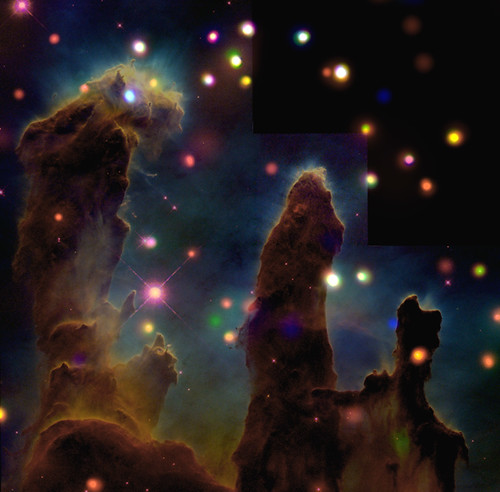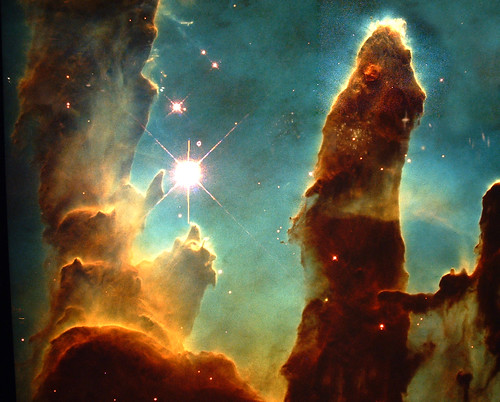


Hubble pics
Slideshow by newtechgirl
5096 views since January 06, 2009.
Get a link button for this slideshow »
Make and share your own slideshow »
1 of 3
The Eagle Nebula (M16): Peering Into the Pillars of Creation (A nearby star-forming region about 7,000 light years from Earth.)
Description: A composite image of the Eagle Nebula (M16) with NASA's Chandra X-ray Observatory and the Hubble Space Telescope penetrates the dark columns of gas and dust to reveal how much star formation is happening there. The Chandra data (red, green, and blue represent low, medium, and high-energy X-rays respectively) show very few X-ray sources in the so-called "Pillars of Creation" themselves. This indicates that star formation peaked in this region several million years ago.
Creator/Photographer: Chandra X-ray Observatory
NASA's Chandra X-ray Observatory, which was launched and deployed by Space Shuttle Columbia on July 23, 1999, is the most sophisticated X-ray observatory built to date. The mirrors on Chandra are the largest, most precisely shaped and aligned, and smoothest mirrors ever constructed. Chandra is helping scientists better understand the hot, turbulent regions of space and answer fundamental questions about origin, evolution, and destiny of the Universe. The images Chandra makes are twenty-five times sharper than the best previous X-ray telescope. NASA's Marshall Space Flight Center in Huntsville, Ala., manages the Chandra program for NASA's Science Mission Directorate in Washington. The Smithsonian Astrophysical Observatory controls Chandra science and flight operations from the Chandra X-ray Center in Cambridge, Massachusetts.
Medium: Chandra telescope x-ray
Date: 2001
Persistent URL: http://photography.si.edu/SearchImage.aspx?id=2505
Repository: Smithsonian Astrophysical Observatory
Collection: Normal Stars and Star Clusters Collection
Gift line: X-ray: NASA/CXC/U.Colorado/Linsky et al.; Optical: NASA/ESA/STScI/ASU/J.Hester & P.Scowen.
Accession number: m16
Photo by Smithsonian Institution
3 of 3
Orion Nebula - new image from Hubble & Spitzer
View large to fully appreciate.
NASA's Spitzer and Hubble Space Telescopes have teamed up to expose the chaos that baby stars are creating 1,500 light years away in a cosmic cloud called the Orion nebula.
This striking infrared and visible-light composite indicates that four monstrously massive stars at the center of the cloud may be the main culprits in the familiar Orion constellation. The stars are collectively called the "Trapezium." Their community can be identified as the yellow smudge near the center of the image.
Swirls of green in Hubble's ultraviolet and visible-light view reveal hydrogen and sulfur gas that have been heated and ionized by intense ultraviolet radiation from the Trapezium's stars. Meanwhile, Spitzer's infrared view exposes carbon-rich molecules called polycyclic aromatic hydrocarbons in the cloud. These organic molecules have been illuminated by the Trapezium's stars, and are shown in the composite as wisps of red and orange. On Earth, polycyclic aromatic hydrocarbons are found on burnt toast and in automobile exhaust.
Together, the telescopes expose the stars in Orion as a rainbow of dots sprinkled throughout the image. Orange-yellow dots revealed by Spitzer are actually infant stars deeply embedded in a cocoon of dust and gas. Hubble showed less embedded stars as specks of green, and foreground stars as blue spots.
Stellar winds from clusters of newborn stars scattered throughout the cloud etched all of the well-defined ridges and cavities in Orion. The large cavity near the right of the image was most likely carved by winds from the Trapezium's stars.
Located 1,500 light-years away from Earth, the Orion nebula is the brightest spot in the sword of the Orion, or the "Hunter" constellation. The cosmic cloud is also our closest massive star-formation factory, and astronomers believe it contains more than 1,000 young stars.
The Orion constellation is a familiar sight in the fall and winter night sky in the northern hemisphere. The nebula is invisible to the unaided eye, but can be resolved with binoculars or small telescopes.
This image is a false color composite where light detected at wavelengths of 0.43, 0.50, and 0.53 microns is blue. Light at wavelengths of 0.6, 0.65, and 0.91 microns is green. Light at 3.6 microns is orange, and 8.0 microns is red.
Image credit: NASA/JPL-Caltech/STScI
[Note (30 July, 2007): Last week there was a Yahoo! News article that included a link to this photo. It shot my views up from about 1,000 views to over 14,000 views in one day!!!!]
Photo by Mr. Physics

